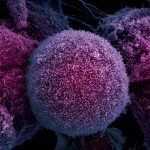Lien vers Pubmed [PMID] – 17875923
Mol. Cell. Biol. 2007 Dec;27(23):8205-14
Ku70 forms a heterodimer with Ku80, called Ku, that is critical for repairing DNA double-stand breaks by nonhomologous end joining and for maintaining telomeres. Mice with either gene mutated exhibit similar phenotypes that include increased sensitivity to ionizing radiation and severe combined immunodeficiency. However, there are also differences in the reported phenotypes. For example, only Ku70 mutants are reported to exhibit a high incidence of thymic lymphomas while only Ku80 mutants are reported to exhibit early aging with very low cancer levels. There are two explanations for these differences. First, either Ku70 or Ku80 functions outside the Ku heterodimer such that deletion of one is not identical to deletion of the other. Second, divergent genetic backgrounds or environments influence the phenotype. To distinguish between these possibilities, the Ku70 and Ku80 mutations were crossed together to generate Ku70, Ku80, and double-mutant mice in the same genetic background raised in the same environment. We show that these three cohorts have similar phenotypes that most resemble the previous report for Ku80 mutant mice, i.e., early aging without substantially increased cancer levels. Thus, our observations suggest that the Ku heterodimer is important for longevity assurance in mice since divergent genetic backgrounds and/or environments likely account for these previously reported differences.

